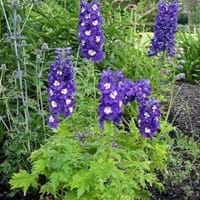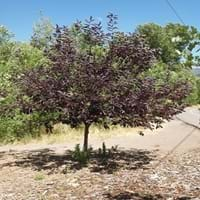Life Span
Perennial
Perennial
Type
Flowering Plants, Ornamental Plants, Shrubs
Tree
Origin
Africa
North America
Types
Not Available
Not Available
Number of Varieties
Not Available
Habitat
gardens, meadows
Moist Soils, open Woodlands, Pine barrens, Swamps
USDA Hardiness Zone
Not Available
3-8
Sunset Zone
Not Available
A1, A2, A3, 1a, 1b, 2a, 2b, 3a, 3b, 10, 16
Habit
Upright/Erect
Thicket/Colonizing
Minimum Width
Not Available
Flower Color
Blue, Indigo, Lavender, Light Purple
Not Available
Flower Color Modifier
Bicolor
Bicolor
Fruit Color
Non Fruiting Plant
Not Available
Leaf Color in Spring
Green
Not Available
Leaf Color in Summer
Light Green
Not Available
Leaf Color in Fall
Green, Yellow green
Not Available
Leaf Color in Winter
Green, Light Yellow, Tan
Not Available
Leaf Shape
Palmate and toothed
Oval
Plant Season
Spring, Summer, Fall, Winter
Spring, Summer, Fall
Sunlight
Full Sun, Partial Sun
Full Sun, Partial Sun, Partial shade
Type of Soil
Clay, Loam, Sand
Clay, Loam, Sand
The pH of Soil
Acidic, Neutral, Alkaline
Acidic, Neutral, Alkaline
Soil Drainage
Well drained
Average
Bloom Time
Not Available
Spring
Tolerances
Heat And Humidity
Not Available
Where to Plant?
Ground, Pot
Ground
How to Plant?
Seedlings, Stem Cutting
Grafting, Seedlings, Stem Planting
Plant Maintenance
Medium
Medium
Watering Requirements
It cannot sustain wet-feet, Keep ground moist, Requires regular watering, Water more in summer
Keep the ground moist but not water-logged, Requires regular watering
In Summer
Lots of watering
Lots of watering
In Spring
Moderate
Moderate
In Winter
Average Water
Average Water
Soil pH
Acidic, Neutral, Alkaline
Acidic, Neutral, Alkaline
Soil Type
Clay, Loam, Sand
Clay, Loam, Sand
Soil Drainage Capacity
Well drained
Average
Sun Exposure
Full Sun, Partial Sun
Full Sun, Partial Sun, Partial shade
Pruning
Cut away fading foliage, Do not prune during shooting season, Remove damaged leaves, Remove deadheads
Remove branches that rub together, Remove dead branches
Fertilizers
High-phosphorous fertilizers used, Organic Flower Fertilizer
All-Purpose Liquid Fertilizer
Pests and Diseases
Bacterial leaf spot, fungus, Mealybugs
Red blotch
Plant Tolerance
Heat And Humidity
Drought
Flower Petal Number
Single
Not Available
Foliage Texture
Fine
Not Available
Foliage Sheen
Matte
Not Available
Attracts
Butterflies
Birds, Butterflies
Allergy
Severe allergen, Skin irritation, Skin rash, Throat itching, Vomiting
Not Available
Aesthetic Uses
Beautification, Borders, Showy Purposes, Used for decorating walls, fences, gates, hedges, etc.
Beautification, Showy Purposes
Beauty Benefits
No Beauty Benefits
Not Available
Environmental Uses
Air purification
Air purification
Medicinal Uses
No Medicinal Use
Asthma, Bronchitis, Cough, Diarrhea, Dysentry, Fever, Stomach Ulcers
Part of Plant Used
Flowers
Bark, Fruits
Other Uses
Used in making blue ink
Used As Food
Used As Indoor Plant
No
No
Used As Outdoor Plant
Yes
Yes
Garden Design
Edging, Feature Plant
Foundation, Hedges, Mixed Border, Screening / Wind Break, Shade Trees
Botanical Name
Delphinium elatum
PRUNUS virginiana
Common Name
Alpine delphinium, Delphium, Candle larkspur, Siberian larkspur, Musk Larkspur,
Wild black cherry, Cherry bark
In Hindi
अल्पाइन Delphinium
Chokecherry
In German
Alpine Delphinium
Chokecherry
In French
Alpine Delphinium
Chokecherry
In Spanish
Alpine Delphinium
Chokecherry
In Greek
Alpine Δελφίνιο
Chokecherry
In Portuguese
Alpine Delphinium
Chokecherry
In Polish
Alpine Delphinium
Chokecherry
In Latin
Alpine Delphinium
chokecherry
Phylum
Tracheophyta
Magnoliophyta
Class
Magnoliopsida
Magnoliopsida
Order
Ranunculales
Rosales
Family
Ranunculaceae
Rosaceae
Clade
Angiosperms, Eudicots
Angiosperms, Eudicots, Rosids
Tribe
Not Available
Amygdaleae
Subfamily
Not Available
Amygdaloideae
Number of Species
Not Available
Properties of Alpine Delphinium and Chokecherry
Wondering what are the properties of Alpine Delphinium and Chokecherry? We provide you with everything About Alpine Delphinium and Chokecherry. Alpine Delphinium doesn't have thorns and Chokecherry doesn't have thorns. Also Alpine Delphinium does not have fragrant flowers. Alpine Delphinium has allergic reactions like Severe allergen, Skin irritation, Skin rash, Throat itching and Vomiting and Chokecherry has allergic reactions like Severe allergen, Skin irritation, Skin rash, Throat itching and Vomiting. Compare all the properties and characteristics of these two plants. Find out which of these plant can be used as indoor plant. If you are interested to decorate your house and garden, find out aesthetic uses, compare them and select the plant which will beautify your surrounding. Along with beautification, try comparing medicinal and edible uses of Alpine Delphinium and Chokecherry and you can choose the plant having best and most benefits.
Season and Care of Alpine Delphinium and Chokecherry
Season and care of Alpine Delphinium and Chokecherry is important to know. While considering everything about Alpine Delphinium and Chokecherry Care, growing season is an essential factor. Alpine Delphinium season is Spring, Summer, Fall and Winter and Chokecherry season is Spring, Summer, Fall and Winter. The type of soil for Alpine Delphinium is Clay, Loam, Sand and for Chokecherry is Clay, Loam, Sand while the PH of soil for Alpine Delphinium is Acidic, Neutral, Alkaline and for Chokecherry is Acidic, Neutral, Alkaline.
Alpine Delphinium and Chokecherry Physical Information
Alpine Delphinium and Chokecherry physical information is very important for comparison. Alpine Delphinium height is 200.00 cm and width Not Available whereas Chokecherry height is 460.00 cm and width 550.00 cm. The color specification of Alpine Delphinium and Chokecherry are as follows:
Alpine Delphinium flower color: Blue, Indigo, Lavender and Light Purple
Alpine Delphinium leaf color: Green
Chokecherry flower color: Not Available
- Chokecherry leaf color: Not Available
Care of Alpine Delphinium and Chokecherry
Care of Alpine Delphinium and Chokecherry include pruning, fertilizers, watering etc. Alpine Delphinium pruning is done Cut away fading foliage, Do not prune during shooting season, Remove damaged leaves and Remove deadheads and Chokecherry pruning is done Remove branches that rub together and Remove dead branches. In summer Alpine Delphinium needs Lots of watering and in winter, it needs Average Water. Whereas, in summer Chokecherry needs Lots of watering and in winter, it needs Average Water.





